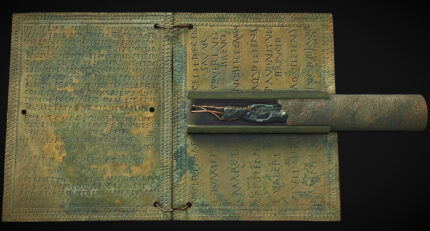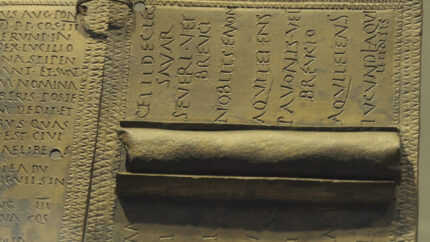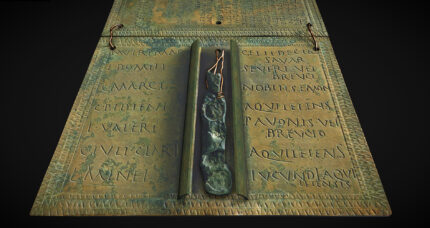 The best-preserved Roman military diploma was dredged up from the River Sava in Slavonski Brod, Croatia, in 1997. It was issued by the emperor Vespasian on February 9th, 71 A.D., to the centurion Liccaius, veteran of the Classis Misenensis (the “Fleet of Misenum“) under the command of Sextus Lucilius Bassus.
The best-preserved Roman military diploma was dredged up from the River Sava in Slavonski Brod, Croatia, in 1997. It was issued by the emperor Vespasian on February 9th, 71 A.D., to the centurion Liccaius, veteran of the Classis Misenensis (the “Fleet of Misenum“) under the command of Sextus Lucilius Bassus.
The diploma states he was born in Marsunia (the Roman name for what is now Slavonski Brod) and was settled on land in Paestum on southern Italy’s Tyrrhenian coast after his honorable discharge. The fact that his diploma was found in the river flowing through his birthplace, however, indicates that at some point after his retirement he left his land grant in southern Italy and went home to Pannonia.
 The rest of his diploma includes the standard boilerplate for these documents. He was granted citizenship for himself, his children, their descendants. He was also granted the right to marry and the citizenship extended to the spouse as well, although this was valid for one wife only, so if he remarried she would not get Roman citizenship through him.
The rest of his diploma includes the standard boilerplate for these documents. He was granted citizenship for himself, his children, their descendants. He was also granted the right to marry and the citizenship extended to the spouse as well, although this was valid for one wife only, so if he remarried she would not get Roman citizenship through him.
 What makes this particular diploma so extraordinary is that is so complete and well-preserved that the wax seals of the witnesses are still attached. The two tablets are tied together through perforations in the bronze. The tablet on the right feature is engraved with the names of the seven witnesses. Witnesses stamped their signatures on wax using their signet rings. Down the middle of the second tablet is a compartment with a slide-out lid where the wax seals of five of the witnesses are contained. This is a unique artifact. No other military diplomas with seals are known to survive.
What makes this particular diploma so extraordinary is that is so complete and well-preserved that the wax seals of the witnesses are still attached. The two tablets are tied together through perforations in the bronze. The tablet on the right feature is engraved with the names of the seven witnesses. Witnesses stamped their signatures on wax using their signet rings. Down the middle of the second tablet is a compartment with a slide-out lid where the wax seals of five of the witnesses are contained. This is a unique artifact. No other military diplomas with seals are known to survive.
Liccaius’ diploma is on display at the Brod Posavlje Museum in Slavonski Brod, but a really kickass 3D model has been made of it where the compartment slides out to reveal the seals. Explore it here:
It almost looks brand new! 😲️
Also a matter of “timing”: If he was retired from Classis Misenensis in 71AD, directly opposite Mt. Vesuvius in Pompeii, he was hopefully elsewhere, when it finally erupted in 79AD.
Pliny the Elder, however, had been ‘praefectus’ of Classis Misenensis, when he organized and led a rescue mission of several galleys across the Gulf of Naples, which he unfortunately did not make it alive from.
The discovery of Liccaius’ Roman military diploma is a remarkable find, showcasing intricate details and unprecedented preservation. Its unique completeness, including intact wax seals, provides a rare glimpse into Roman military history. The 3D model enhances this experience, allowing viewers to explore this extraordinary artifact up close. A true treasure for history enthusiasts!